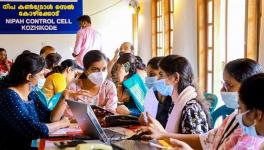Explainer: What Do We Know About Lambda Variant
Emergence of newer variants of SARS-CoV-2, the coronavirus that has caused the COVID-19 pandemic, are causing more and more concerns across the world.
Viruses undergo mutation as a natural phenomenon. Mutations are basically the minor changes in the genetic material (in case of SARS-CoV-2, it is RNA), and all such changes do not offer the virus any benefits or loss either. However, some such mutations can prove harmful for the virus while other mutations can provide it with evolutionary benefits, for example, greater transmissibility or more lethality.
SARS-CoV-2 has also undergone numerous such mutations, not all of which have been a cause for concern. However, there are certain changes that have forced scientists to take up more intensive studies about them.
One such a variant is the Lambda variant. While many speculations about this variant are circulating, there are some points which need to be considered to understand how it behaves.
What is the Lambda Variant?
The Lambda variant is a new variant of the coronavirus. In late June, the World Health Organisation (WHO) listed Lambda as a ‘variant of interest’. There are some early data which suggest that the this variant may be more transmissible than the previous ones and it may also have the ability to escape the protection provided by vaccines. However, none of these findings have been accepted as conclusive.
What is a ‘Variant of Interest’ (VOI) and what is a ‘Variant of Concern’ (VOC)?
WHO defines a VOI as a variant that is predicted or known to affect the characteristics of the virus such as transmissibility, disease severity, immune escape or diagnostic and therapeutic escape. Along with these, a variant can be a VOI if it is identified to cause large scale community transmission in multiple countries with an increase in the relative prevalence with increasing number of cases.
On the other hand, a VOC, according to WHO, is a variant that fulfills the criteria of being a VOI along with other traits such as increase in transmissibility or detrimental change in the epidemiology of the disease; increase in virulence; decrease in effectiveness of the available public health measures or available diagnostics, vaccines or therapies.
There are four VOCs as enlisted by WHO so far – Alpha, Beta, Gamma and Delta variants. These variants have shown signs of increasing transmissibility.
Detection of the Lambda Variant
Also known as the C.37, the Lambda variant was first detected in Peru in December last year. At the time, this variant reportedly accounted for only 1 in every 100 cases. However, currently the Lambda variant accounts for over 80% of the cases in the country. Peru also has one of the highest mortality rates of COVID-19 currently, but it is not conclusive yet whether the high mortality is ascribable to the Lambda variant alone.
This variant is not restricted to Peru. According to GISAID data, this variant has expanded to 31 countries now, including US, Chile, Germany, Mexico, Argentina, Spain, Ecuador and Israel.
The GISAID database is the global repository of the information about genetic sequencing of the SARS-CoV-2 virus. Genetic sequencing can tell what changes are taking place in the genetic material of this virus.
Is Lambda Vaccine Resistant
Speculations are high in this regard, but nothing conclusive has come out yet. To say conclusively whether the variant is really capable of evading vaccine protection, more studies will have to be conducted.
A paper published in the preprint server medRxiv suggests that the variant can escape the neutralising antibodies produced by the CoronaVac vaccine. The study was conducted by researchers in Chile.
Get the latest reports & analysis with people's perspective on Protests, movements & deep analytical videos, discussions of the current affairs in your Telegram app. Subscribe to NewsClick's Telegram channel & get Real-Time updates on stories, as they get published on our website.
























